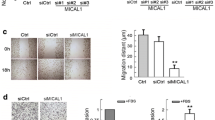Abstract
To explore the role of a novel Obg-like ATPase 1 (OLA1) in cancer metastasis, small interference RNA (siRNA) was used to knockdown the protein, and the cells were subjected to in vitro cell migration and invasion assays. Knockdown of OLA1 significantly inhibited cell migration and invasion in breast cancer cell line MDA-MB-231. The knockdown caused no changes in cell growth but affected ROS production. In wound-healing assays, decreased ROS in OLA1-knockdown cells were in situ associated with the cells’ decreased motile morphology. Further, treatment of N-acetylcysteine, a general ROS scavenger, blunted the motility and invasiveness of MDA-MB-231 cells, similar to the effect of OLA1-knockdown. These results suggest that knockdown of OLA1 inhibits breast cancer cell migration and invasion through a mechanism that involves the modulation of intracellular ROS levels.
Similar content being viewed by others
References
Alexandrova, A.Y., Kopnin, P.B., Vasiliev, J.M., Kopnin, B.P., 2006. ROS up-regulation mediates Ras-induced changes of cell morphology and motility. Exp. Cell Res., 312(11): 2066–2073. [doi:10.1016/j.yexcr.2006.03.004]
Chène, P., 2002. ATPases as drug targets: learning from their structure. Nat. Rev. Drug Discov., 1(9):665–673. [doi:10.1038/nrd894]
Ferraro, D., Corso, S., Fasano, E., Panieri, E., Santangelo, R., Borrello, S., Giordano, S., Pani, G., Galeotti, T., 2006. Pro-metastatic signaling by c-Met through RAC-1 and reactive oxygen species (ROS). Oncogene, 25(26): 3689–3698. [doi:10.1038/sj.onc.1209409]
Fini, M.A., Orchard-Webb, D., Kosmider, B., Amon, J.D., Kelland, R., Shibao, G., Wright, R.M., 2008. Migratory activity of human breast cancer cells is modulated by differential expression of xanthine oxidoreductase. J. Cell. Biochem., 105(4):1008–1026. [doi:10.1002/jcb.21901]
Gradia, D.F., Rau, K., Umaki, A.C., de Souza, F.S., Probst, C.M., Correa, A., Holetz, F.B., Avila, A.R., Krieger, M.A., Goldenberg, S., et al., 2009. Characterization of a novel Obg-like ATPase in the protozoan Trypanosoma cruzi. Int. J. Parasitol., 39(1):49–58. [doi:10.1016/j.ijpara.2008.05.019]
Hortobagyi, G.N., de la Garza Salazar, J., Pritchard, K., Amadori, D., Haidinger, R., Hudis, C.A., Khaled, H., Liu, M.C., Martin, M., Namer, M., et al., 2005. The global breast cancer burden: variations in epidemiology and survival. Clin. Breast Cancer, 6(5):391–401. [doi:10.3816/CBC.2005.n.043]
Huo, Y., Qiu, W.Y., Pan, Q., Yao, Y.F., Xing, K., Lou, M.F., 2009. Reactive oxygen species (ROS) are essential mediators in epidermal growth factor (EGF)-stimulated corneal epithelial cell proliferation, adhesion, migration, and wound healing. Exp. Eye Res., in press [Epub ahead of print]. [doi:10.1016/j.exer.2009.07.012]
Ikeda, S., Yamaoka-Tojo, M., Hilenski, L., Patrushev, N.A., Anwar, G.M., Quinn, M.T., Ushio-Fukai, M., 2005. IQGAP1 regulates reactive oxygen species-dependent endothelial cell migration through interacting with Nox2. Arterioscler. Thromb. Vasc. Biol., 25(11):2295–2300. [doi:10.1161/01.ATV.0000187472.55437.af]
Koller-Eichhorn, R., Marquardt, T., Gail, R., Wittinghofer, A., Kostrewa, D., Kutay, U., Kambach, C., 2007. Human OLA1 defines an ATPase subfamily in the Obg family of GTP-binding proteins. J. Biol. Chem., 282(27):19928–19937. [doi:10.1074/jbc.M700541200]
Moldovan, L., Moldovan, N.I., Sohn, R.H., Parikh, S.A., Goldschmidt-Clermont, P.J., 2000. Redox changes of cultured endothelial cells and actin dynamics. Circ. Res., 86(5):549–557.
Moldovan, L., Mythreye, K., Goldschmidt-Clermont, P.J., Satterwhite, L.L., 2006. Reactive oxygen species in vascular endothelial cell motility. Roles of NAD(P)H oxidase and Rac1. Cardiovasc. Res., 71(2):236–246. [doi:10.1016/j.cardiores.2006.05.003]
Nishikawa, M., 2008. Reactive oxygen species in tumor metastasis. Cancer Lett., 266(1):53–59. [doi:10.1016/j.canlet.2008.02.031]
Olson, M.F., Sahai, E., 2009. The actin cytoskeleton in cancer cell motility. Clin. Exp. Metastasis, 26(4):273–287. [doi:10.1007/s10585-008-9174-2]
Pendyala, S., Gorshkova, I.A., Usatyuk, P., He, D., Pennathur, A., Lambeth, J.D., Thannickal, V.J., Natarajan, V., 2008. Role of Nox4 and Nox2 in hyperoxia-induced reactive oxygen species generation and migration of human lung endothelial cells. Antioxid. Redox Signal, 11(4):747–764. [doi:10.1089/ars.2008.2203]
Radisky, D.C., Levy, D.D., Littlepage, L.E., Liu, H., Nelson, C.M., Fata, J.E., Leake, D., Godden, E.L., Albertson, D.G., Nieto, M.A., et al., 2005. Rac1b and reactive oxygen species mediate MMP-3-induced EMT and genomic instability. Nature, 436(7047):123–127. [doi:10.1038/nature03688]
Shim, H., Shim, E., Lee, H., Hahn, J., Kang, D., Lee, Y.S., Jeoung, D., 2006. CAGE, a novel cancer/testis antigen gene, promotes cell motility by activation ERK and p38 MAPK and downregulating ROS. Mol. Cells, 21(3): 367–375.
Steeg, P.S., 2006. Tumor metastasis: mechanistic insights and clinical challenges. Nat. Med., 12(8):895–904. [doi:10.1038/nm1469]
Storz, P., 2005. Reactive oxygen species in tumor progression. Front. Biosci., 10(1–3):1881–1896. [doi:10.2741/1667]
Valko, M., Leibfritz, D., Moncol, J., Cronin, M.T., Mazur, M., Telser, J., 2007. Free radicals and antioxidants in normal physiological functions and human disease. Int. J. Biochem. Cell Biol., 39(1):44–84. [doi:10.1016/j.biocel.2006.07.001]
Weigelt, B., Peterse, J.L., van’t Veer, L.J., 2005. Breast cancer metastasis: markers and models. Nat. Rev. Cancer, 5(8): 591–602. [doi:10.1038/nrc1670]
Wu, W.S., 2006. The signaling mechanism of ROS in tumor progression. Cancer Metastasis Rev., 25(4):695–705. [doi:10.1007/s10555-006-9037-8]
Zhang, J., Rubio, V., Lieberman, M.W., Shi, Z.Z., 2009. OLA1, an Obg-like ATPase, suppresses antioxidant response via nontranscriptional mechanisms. Proc. Natl. Acad. Sci. USA, 106(36):15356–15361. [doi:10.1073/pnas.0907213106]
Author information
Authors and Affiliations
Corresponding authors
Additional information
Project supported by the National Basic Research Program (973) of China (No. 2004CB518707) and the Methodist Hospital Research Institute, USA
Rights and permissions
About this article
Cite this article
Zhang, Jw., Rubio, V., Zheng, S. et al. Knockdown of OLA1, a regulator of oxidative stress response, inhibits motility and invasion of breast cancer cells. J. Zhejiang Univ. Sci. B 10, 796–804 (2009). https://doi.org/10.1631/jzus.B0910009
Received:
Accepted:
Published:
Issue Date:
DOI: https://doi.org/10.1631/jzus.B0910009




